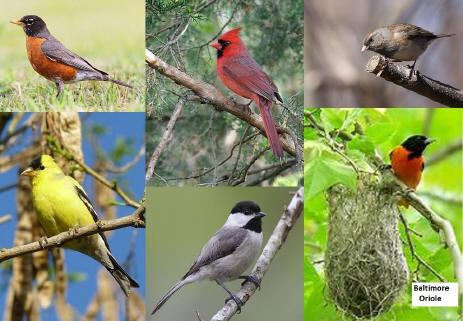(1/19) Many birds have migrated south for the winter, but many are still here! In the harsh Pennsylvania winter, birds are searching for food, water, and shelter. So hang up your feeders and fill up your bird baths! The birds will appreciate your help. Another way to help birds is to participate in the Great Backyard Bird Count.
The Great Backyard Bird Count (GBBC) is a worldwide bird monitoring program that anyone can do anywhere – including your own backyard. It is easy to participate. Count the number of birds you see for at least 15 minutes, then report it at http://gbbc.birdcount.org/. In 2017, the count will take place February 17 – 20.
 Last year, 138 different bird species were counted in Pennsylvania. Among the most frequently counted birds were the American robin, cedar waxwing, dark-eyed junco, American goldfinch, red-winged blackbird, mourning dove, and Northern cardinal. It is helpful to be familiar with the common
birds before the count (and makes watching birds more fun!). Here are some tips for winter birding:
Last year, 138 different bird species were counted in Pennsylvania. Among the most frequently counted birds were the American robin, cedar waxwing, dark-eyed junco, American goldfinch, red-winged blackbird, mourning dove, and Northern cardinal. It is helpful to be familiar with the common
birds before the count (and makes watching birds more fun!). Here are some tips for winter birding:
American robin – These birds have a rust-colored belly and tend to hop about on the ground. They are not big fans of seeds, but they may pick up a dried mealworm or peck at an apple slice!
American goldfinch – They will not be the brilliant yellow of summer. In February, the American goldfinch is more concerned with blending in than attracting mates. They are dull-colored, with hints of yellow and black.
Northern cardinal – There is no mistaking this red bird! Look for the cardinal’s "Mohawk" (crest) and black face mask. A female may be lurking nearby. She will also have the crest, but her colors will be muted. The male often stands guard while she eats and lures predators away if she needs to escape.
Carolina Chickadee – Some call this bird the "Oreo" bird because of its black and white striped face. This little puff ball likes to visit seed feeders. It picks up one seed in its beak, flits off to a nearby tree, and eats it. As you watch them fly back and forth, listen for its call chickadee-dee-dee.
Dark-eyed junco – It is not often that you see just one junco. They tend to move in a flock close to the ground. They are slate-gray, although some have a pronounced brown head. The best way to identify the junco is to watch them fly away. If you see a flash of white on their outer tail feathers, then you may be looking at a junco.
Are you looking to attract more birds to your yard? Install bird feeders with a variety of seeds – black-oil sunflower seeds are a favorite for many birds. Be sure that the birds can see the seeds. Next fall, slow down with the dead-heading and let your native plants go to seed. Provide a source of water for the birds and roosts to keep them warm
at night. Be patient. The birds will find you!
The Great Backyard Bird Count provides important information for scientists who are studying bird migration, population size and distribution, and more. Researchers cannot be everywhere at once so they rely on citizen scientists like you. Learn more about the Great Backyard Bird Count at http://gbbc.birdcount.org/.
Read other articles on birds, wildlife & beneficial insects
Read more articles by Kim Schubert